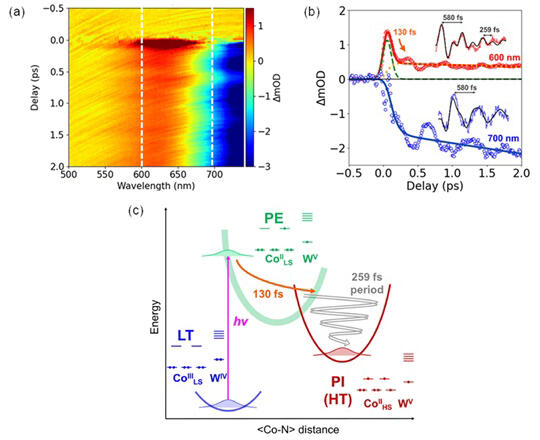A joint research team consisting of Professor Shin-ichi Ohkoshi, Graduate Student Kazuki Nakamura (at the time of research), and Assistant Professor Koji Nakabayashi from the Graduate School of Science at the University of Tokyo, along with Professor Eric Collet and his colleagues from the Institute of Physics at the University of Rennes, France, announced on June 6 that they discovered that in materials exhibiting photoinduced phase transitions where charge transfer (CT) and spin transition (ST) coexist, charge transfer occurs first upon light irradiation, followed by spin transition. This was found using femtosecond laser ultrafast spectroscopic measurements.

(a) Optical density changes measured at room temperature.
(b) Optical density changes at 600 nm (red circles) and 700 nm (blue circles).
(c) Schematic of the ultrafast dynamics of the light-induced phase transition.
Provided by the University of Tokyo
Charge-transfer spin transition materials that exhibit vivid color changes between blue and red crystals have been the subject of debate for a quarter century regarding whether the charge transfer or the spin transition drives the phase transition. This research has demonstrated that charge transfer occurs first, followed by spin transition.
The research team focused on cyanido-bridged cobalt (Co)-tungsten (W) integrated compounds that can induce vivid color changes through external stimuli. These materials are known to exhibit photoinduced magnetization phenomena through phase transitions with temperature hysteresis loops, derived from transitions between the blue crystal phase (low-temperature phase) CoIIILS-WIV state and the red crystal phase (high-temperature phase) CoIIHS-WV state (discovered by Ohkoshi et al. in 2003).
In this study, the team investigated Cs+0.1(hydronium ion)0.9[Co(4-bromopyridine)2.3{W(CN)8}] (referred to as CsCoW), which exhibits bistable temperature phase transitions between high-temperature and low-temperature phases.
When light is irradiated onto CsCoW in its low-temperature phase state, phase transition occurs, and a photoinduced phase emerges with observable changes in color and magnetic properties. The research team used femtosecond time-resolved optical spectroscopy to investigate the ultrafast dynamics of photoinduced phase transitions by observing changes in optical density.
As a result, they observed that photoexcitation first causes charge transfer from WIV to a CoIIILS state, generating a CoIILS-WV state from the blue crystal phase CoIIILS-WIV state. This charge transfer was completed within approximately several tens of femtoseconds after photoexcitation.
Furthermore, within approximately 130 femtoseconds of this charge transfer, they captured an ultrafast spin transition where the cobalt spin state transitions from low-spin to high-spin state.
In this spin transition process, a short-lived photoexcited phase (CoIILS-WV state) is formed, and the process by which this state transitions to the final red crystal phase high-spin state (CoIIHS-WV) was clarified. The team also achieved other outcomes; for example, periodic changes in optical density were observed after transient peaks, suggesting that activation of specific crystal lattice vibrations promotes this spin transition.
This achievement elucidates the relationship between charge transfer and spin transition in materials exhibiting vivid changes, providing new insights into understanding mechanisms of ultrafast photoinduced processes.
Based on this achievement, the research team expects that further optimization of material design and synthesis methods could enable practical application of optomagnetic devices with high-speed response and control capabilities that surpass conventional electronic devices. This research achievement is noted for its potential to bring significant ripple effects not only to materials science but also to the fields of electronic engineering and information communication technology.
Journal Information
Publication: Nature Communications
Title: Ultrafast charge-transfer-induced spin transition in cobalt-tungstate molecular photomagnets
DOI: 10.1038/s41467-025-60401-4
This article has been translated by JST with permission from The Science News Ltd. (https://sci-news.co.jp/). Unauthorized reproduction of the article and photographs is prohibited.




